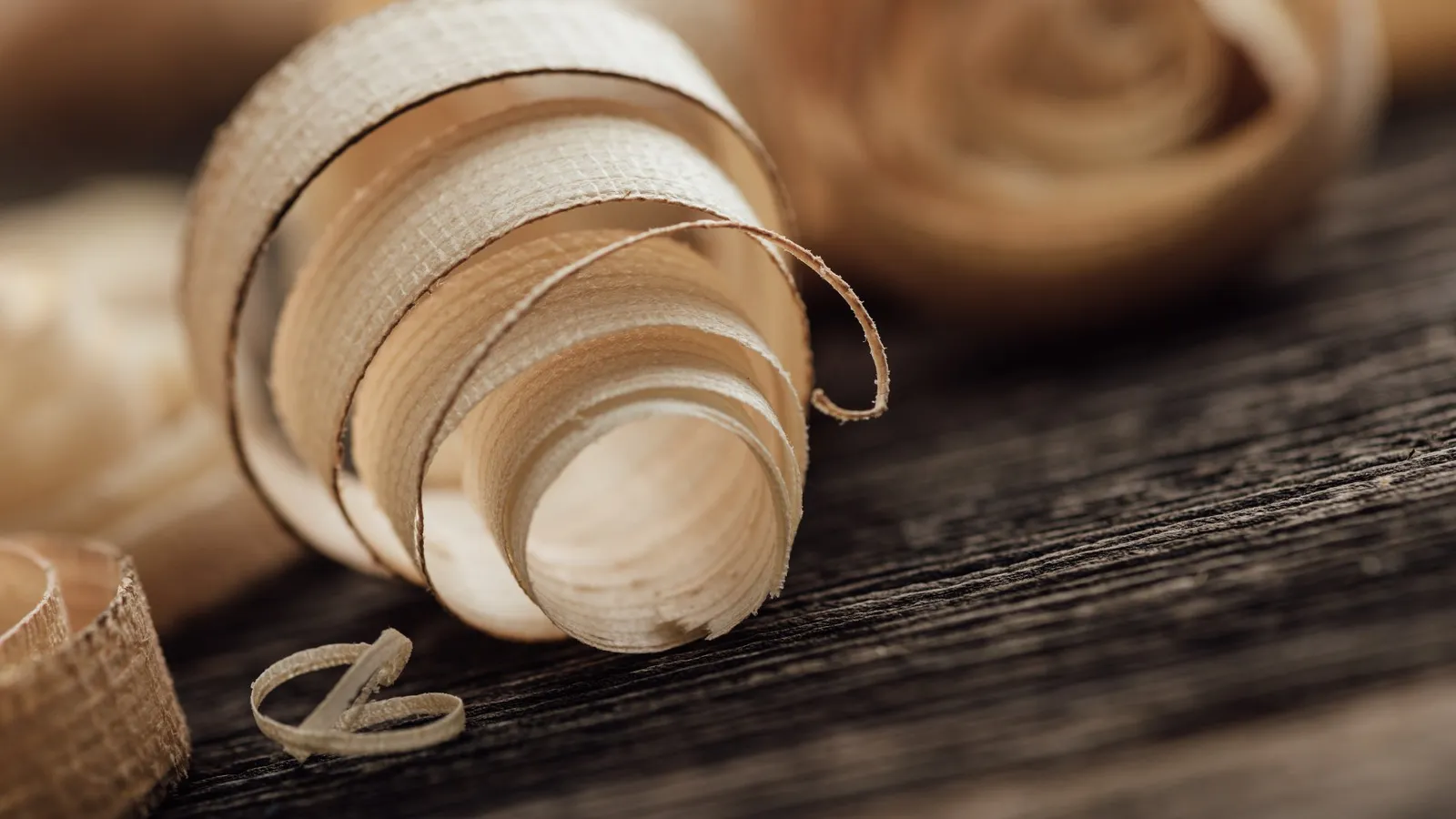The shank of wood is dry, and splintered at its base, and corrugated with rough grain where I have split it with an ax from the fallen log. A layer of bark, silvered and mottled, lies along one edge. A blush of darker color in the wood, speckled with a webbing of thin black lines, indicates where fungus entered the trunk after the tree fell. I press upon these marks, searching for soft and punky wood, but I find the structure still solid. Birch is a strong wood. It resists destruction. Perhaps the fungal areas will be stripped off as I turn the wood on the lathe. Or perhaps they persist to the core, and will become scalloped shapes in the finished bowl. I’m ambivalent about which outcome to hope for. Fungal decorations, called spalting by woodworkers, often yield remarkable patterns of beauty and intensity. Yet the process of revealing such patterns, the slicing and scraping and sanding, sometimes releases fungal spores into the air. These can find their way into human lungs and are capable of causing serious illness. I try not to worry about this.
I secure the wood in the lathe. An adjustable chuck holds it at one end, while a spur of sharpened metal digs in at the other. Mounted so, the piece looks like an ordinary stick of firewood grasped by complicated bits of machinery at either end. Beneath the lathe, hillocks of chips and shavings and wood dust have accumulated from the three bowls I’ve previously turned from the same tree, the one felled by the storm four years ago. Had the wind shifted ten degrees to the east, the tree would have crushed the roof of our cabin. Instead it crashed to the forest floor, lay there for a short stretch of seasons, then was sawn into rounds and riven into blanks for turning.
Slowly, by hand, feeling for slack in the mounting, looking for cracks in the wood, I turn the piece on the lathe. Even now, oxidized and smeared with dirt, the surface grain is the color of pure honey. Its hues will deepen and grow marbled, and will resolve the architecture of the wood with great clarity as I lay bare, with sharp steel heated by friction, the shape of a fluted bowl with tattered bark upon its rim. At least, this is my vision of the finished piece. But the wood may possess its own imperatives. It may hide terminal cracks, knots, twists, or variances in density. Any of these might draw my hands to fashion a different shape than the one I imagine, or cause the developing bowl to fracture. One precise method exists for discovering what will happen.
I pull down my face shield, flip the power switch on the lathe, and start the motor humming. The piece turns, flashing bark and grain. I nudge the speed dial, ratcheting the revolutions upward. Then I select a cutting tool, a turning gouge with a rounded profile, and lay it against the tool rest near the spinning wood. The flat shoulder of the tool rest is a fulcrum that stabilizes the gouge, enables a slow and cautious approach to the wood, facilitates pressing and sculpting. I edge the tool forward, sliding it across the open space between the tool rest and the wood. This is the most difficult moment of the project: before the initial cut, when I do not yet know exactly where the tool will catch the wood, when the impact might jolt the piece from the lathe, or hammer the gouge backward and toward me. Before I traverse the final space between the wood and the tool, I glance upward to the totem figure that hangs above my workbench. I carved it from a fishing float when I was a child, gifted it to my grandmother, with whom I lived during several of my difficult teenage years, and inherited it back from her when she died. Were it not for her care, her commitment to a lost boy, I might well have followed the paths of Trench and all the other stimulant users: restless, angry, fugitive. In many ways I did follow such paths but later, as I struggled through my early adulthood. But eventually I was carried home – because I knew what it felt like, what I was looking for. My grandmother offered me this gift, my wife opened me to it, my children welded me to it. I found my center, finally. But no one offered such gifts to Trench. And now, perhaps, he has gone too far to accept them.
Despite my anxiety, the beginning goes well: the gouge slices into the wood’s irregular orbit and begins to pare it down. Long shavings spiral out from the tool’s edge. I listen: to the whir of the lathe motor, to the ribbons of shorn wood hissing, to the thunk of a dense knot as it slides around to meet the steel with every rotation. Wood turning is an act of tuning, of finding cadences and harmonies by which the wood ceases its restless vibration and settles into resonance. Perhaps more than my eyes, my ears tell me if the cut is too shallow, if I’m in danger of digging too deep into the wood, if I should ease up along the shoulder of the emerging bowl. This music guides me.
The piece submits to being shaped. Its vibrations settle down into a regular, thrumming rhythm; a ticking, as some woodworkers describe it. Slowly, as thousands of shavings are drawn from the wood and into the air, the bowl’s external contours become balanced around a still and revolving center. This center, which runs along the axis between the two mounting points of the lathe, does not move or vibrate. It is a fixed line, unremarkable and unchangeable. It governs the life and spirit of the work.
I shape the bowl’s outer rim, wide shoulder, and slender base. I listen for the sounds of smooth and singular rotation, of the center undisturbed by vibration or chatter. I watch the spalted patterns emerge. I think of the coyote I saw on the ridge above the grove where this wood once grew.
When the outer surface is done, when the grain is sheared and shimmering and the contour matches my vision of the work, I flip the power switch, remove the bowl from its mounting, and turn it around. I secure it again, placing its newly turned base in the chuck, backing off the spur of metal that had secured the other end, and allowing the solid interior to float free. I adjust the tool rest so that it faces the bowl’s core. Then I start again, hollowing out the wood, making spiral cuts around the center, easing deeper.
As I work, I notice the external circumference of the bowl. It is so smooth that at a quick glance it appears to be still, not spinning or moving at all. I place a finger on the outer shoulder – gently, tentatively, recognizing that this is probably not prudent: bare skin against newly shorn wood whirling at a thousand revolutions per minute. But the pad of my finger is not abraded or punctured with slivers. The birch spins beneath it. The contact is gentle, the surface fully centered.
I continue excavating, forming the inner wall in stages, matching its contours to the outer shape. I try to make the wall as slender as I can, perhaps the thickness of a dozen sheets of paper. I work slowly, increasingly aware of the risk of catching the gouge and puncturing the wall. But the rotations remain smooth, the bowl becomes lighter, translucent almost.
Then the sound begins: a low and persistent hum, deepened and made more insistent as I reach with the tool all the way down to make the shallow contour of the base. I draw the steel along the inner wall, climb back up, steal tiny shavings. The sound rises in pitch and volume. The bowl has begun to behave like a musical instrument, resonating as it meets the tool, acting like the skin of a drum or the reed of a woodwind. It’s a lovely sound: earthy, constant. It reminds me of strong wind rushing through a narrow canyon, of the storm the other day, of the pressing questions of children.
The wall is thin enough now that light from the window passes through, scatters among the patterns of grain, and glows on the inner surface. The light is of an amber cast, like sunrise in late summer. I must stop soon, or I might winnow the wall beyond its strength. But I know that this wood is hardy: another turned bowl from this same tree is similarly thin, and several times I have knocked it from the windowsill beside my desk. The bowl has fallen four feet to the hardwood floor, bounced, spun around in the air, bounced a few more times, then come to rest without damage.
I choose a flat scraping tool, and with the gentlest of strokes I narrow the wall by another hundredth of an inch. The translucency increases, the pitch of the bowl’s humming rises slightly, and I withdraw the tool. I inspect the top rim, where beneath a ragged patch of bark the inner surface is still marginally rough. I could clean this up later, with sandpaper, but I have the scraper in my hand and the lathe is running and I want to finish this stage of the project so that I can flood the surface with finishing oil and coax the warmest beauty from the wood. I move the scraper along the tool rest and carefully, slowly nudge it against the wood. The sound grows louder, deeper. I ease off, then come forward again. A sliver of shaving ghosts from the surface, gossamer thin. I hold the tool, listening, watching for shudders in the wood, feeling through the steel for the stability of the bowl’s center. I come forward with the sharp edge of the tool one last time, touching the wood with a tiny stroke, a caress almost.
The bowl shatters.


